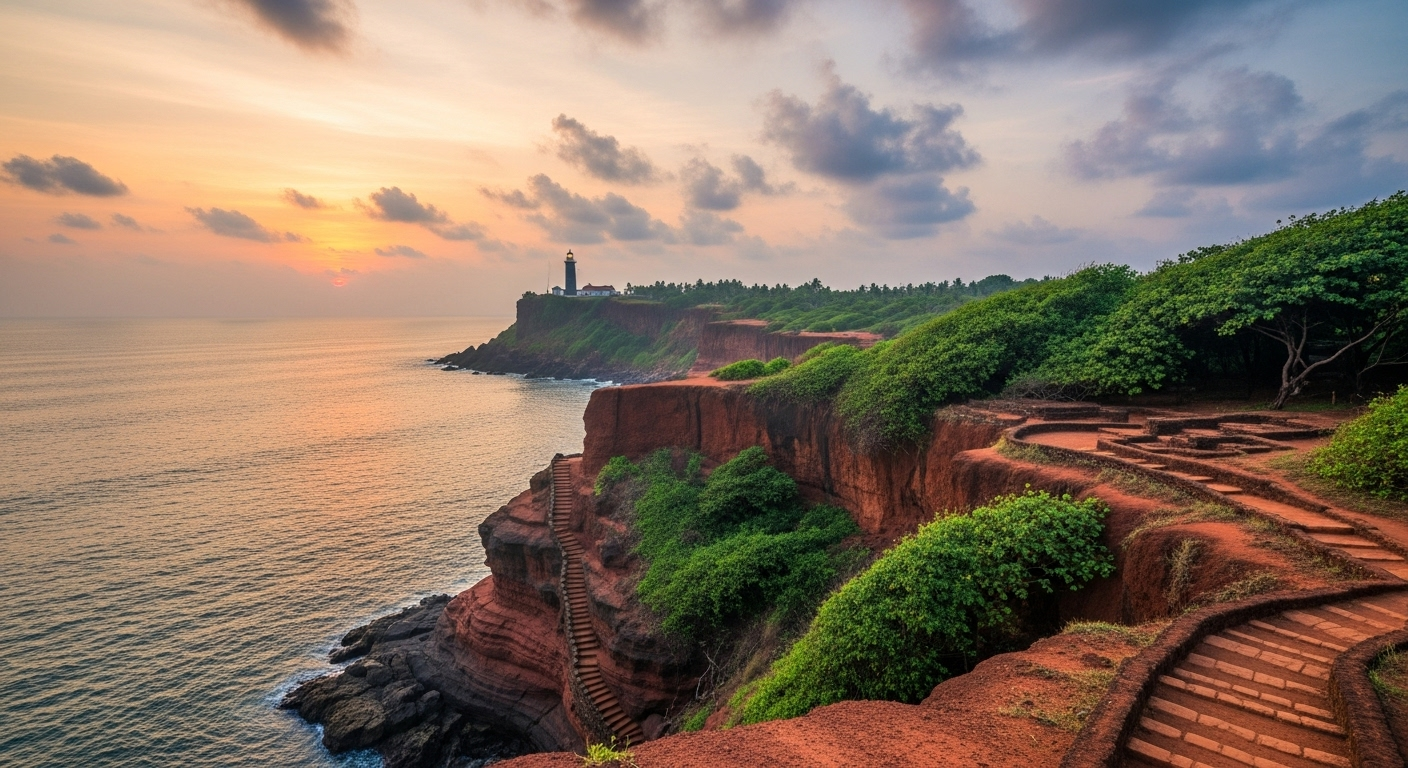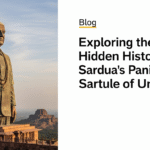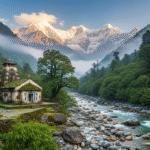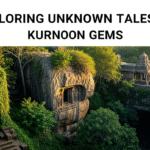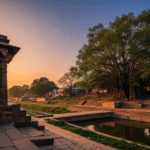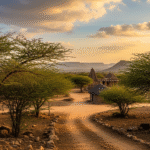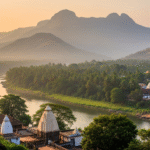Varkala is at Kerala’s southern tip. It’s more than a peaceful spot. It holds a past full of secrets. These secrets have lived for thousands of years. They can be heard on its spiritual beaches and seen in its geological wonders.
The ancient Varkala Cliffs show the town’s old importance and its geological uniqueness. They tell stories that mix myths with truth. This makes Varkala a fascinating place.
The 2000-year-old Janardana Swami Temple and Papanasam Beach attract many people. They come to Varkala to find peace and to hear its old stories. Exploring Varkala is like reading an epic book full of captivating tales. It invites the curious to explore its deep history. This way, they can feel Varkala’s mysterious vibe and its link to old times.
Key Takeaways
- Varkala, with its mysterious past, offers a unique blend of tranquility and historical intrigue.
- Geological wonders like the Varkala Cliffs present a monumental connection to the town’s ancient roots.
- The holy Papanasam Beach and the Janardana Swami Temple are central to Varkala’s spiritual heritage.
- Varkala’s enigmatic presence appeals to those seeking both spiritual enlightenment and archaeological insights.
- Digging into Varkala historical secrets reveals a rich tapestry of myths and realities preserved through time.
The Ancient Roots of Varkala
Varkala’s past is a mix of nature and myths. These stories have shaped its culture and land. The famous Varkala Cliffs are known for their stunning looks. They are a key part of Varkala’s natural wonders.
Varkala’s Geological Formation and the Cliffs
The cliffs are proof of Earth’s changes over millions of years. They are mostly made of layers of sedimentary rock. This makes them special to those who study rocks and nature lovers. Their beauty is more than what meets the eye. They show how Earth keeps changing and evolving. These cliffs also stand strong against erosion by the sea. This makes them important to geologists worldwide.
Mythology and Varkala’s Place in Sacred Texts
Varkala is important in many sacred stories. Its cliffs are seen as a purifying spot in these tales. Legends say a sage named Narada threw a valkalam here. This act created the sacred Varkala Cliff. This mix of nature and legends adds to Varkala’s rich history. It attracts pilgrims and visitors who love its magical past.
| Feature | Importance | Description |
|---|---|---|
| Varkala Cliffs | Geological Wonder | Proof of Earth’s ancient changes |
| Mythological Significance | Cultural Importance | Enhances religious value through sacred texts |
| Natural Preservation | Ecological/Conservational | Center of efforts to save the environment |
Varkala’s old stories and conservation efforts are closely linked. This connection makes it more than just a place to visit. It is a valued natural treasure. It continues to inspire and teach those who learn its age-old tales.
Mysterious history of Varkala
Varkala is a town full of secrets and charm. It’s famous for its amazing cliff. This cliff is about 6 km long and is 30 metres high. It shows how amazing our Earth is, dating back 23 million years. The history and culture around this cliff show Varkala historical significance.
In 2014, the cliffs got a special title for being so unique. They became the 27th National Geological Monument. This award shows their beauty and the possible Varkala archaeological findings. Even though the cliffs are wearing away, people are trying hard to save them. They use plants and coir mats to keep them strong.
Varkala is not just cliffs. It has over 200 cafes and resorts, many close to the cliff. The town is careful to keep people and nature safe. Laws are in place to protect both. Yet, what makes Varkala special is more than its cliffs. Its rich culture and history also draw people in.
Many groups are working to save Varkala’s cliffs. They want them to last for more kids to see. Varkala is as important as other famous places in India. It holds a big spot in the story of our planet and culture.
Varkala’s past is very intriguing. It’s not just about the cliffs or the sea. It’s also about the festivals and the life here. Varkala’s story is still being told, making it a real treasure on India’s coast.
Significance of Varkala Through the Ages
Varkala, a beautiful town, is full of nature and history. It has seen many Varkala historical milestones over the years. Many major empires in Varkala have left their mark. Varkala’s history and culture make it a fascinating place to discover.
Varkala during the Sangam Period
In the Sangam period, Varkala played a big part in South India’s history. It was key for trade, linking the peninsula with the world. Artifacts found in Varkala show its rich history and culture exchanges.
Influence of Major Empires
Major empires in Varkala have come and gone. Each one added something special to the town. They helped to build its architecture, economy, and society. These influences from past empires make Varkala interesting to historians and tourists.
Archaeological Findings and Revelations
Exploring Varkala has brought to light its ties to ancient times and spiritual ways. The Varkala archaeological discoveries have given us new insights. They help us see the region differently.
Ancient Burial Sites and Their Secrets
The ancient burial sites in Varkala show how people long ago dealt with death. They reveal the customs and social life of those times. Studying these sites has helped archaeologists learn about their beliefs in the afterlife.
Discovery of Ancient Temples and Remnants
In Varkala, old temples have been found, giving clues about the spiritual life there. These temples show the area was important for religion. They had advanced building skills and knew about the stars and sacred buildings.
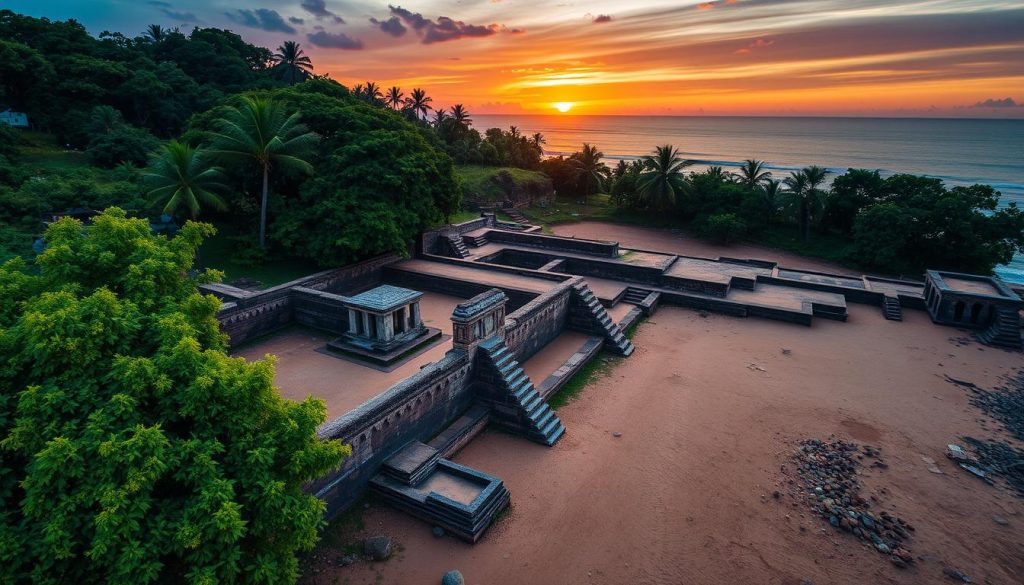
The Varkala archaeological discoveries help us see how people in Varkala lived with nature and practiced their faith. These findings keep changing what we know about this fascinating area.
The Enigmatic Past: Myths and Legends
Varkala’s culture is deep and full of stories. These Varkala myths and legends make the city mysterious. Its past is kept alive in both writings and the stories people tell. These stories have been shared for many years.
Tales of Sage Narada and the Paapanasham Beach
The story of Sage Narada is very interesting. Locals believe Lord Vishnu sent him to Earth. He landed at what is now Paapanasham Beach. This place is thought to wash away sins. It’s an important part of Varkala’s spiritual story.
Folklore of the Sivagiri Mutt and Saint Sree Narayana Guru
The Sivagiri Mutt is important and full of legends. Saint Sree Narayana Guru started it. He wanted everyone to be treated the same, no matter their caste. The story of how he started the Mutt tells us a lot about respect and equality.
The tales of Varkala, like those about Sage Narada and Sivagiri Mutt, are very meaningful. They show the deep culture and spirituality of the area. These stories make people want to learn more about Varkala’s history.
Hidden Gems: Unexplored Historical Sites of Varkala
Varkala, a coastal town in Kerala, is known for its stunning cliffs and clean beaches. It also has a lot of hidden history waiting to be found. Even though it’s popular with tourists, many historical sites in Varkala are still unexplored. These sites tell stories that give us more understanding of the region’s rich past.
These unexplored places are more than just attractions. They have witnessed hundreds of years of cultural changes and historical events. These events have helped shape Varkala into what it is today. From old settlements to remains from the time of colonization, Varkala has hidden history. This history is yet to be discovered and shared, which will add to Varkala’s heritage story.
- Age-old forts hidden among the foliage, their origins and stories lost to time.
- Undiscovered ancient temples, their architecture unique to the periods they were built in.
- Historic trade routes that once buzzed with activity from local and foreign traders.
For anyone who loves history or just loves to explore, these sites are fascinating. Discovering these places is exciting, not just because you’re seeing history. It’s also because you might find something totally new. That discovery could change how we understand Varkala’s history and culture.
Visiting these places needs care and respect. It’s important to remember we need to keep these sites safe for the future. By looking at these unexplored sites in Varkala, we add to India’s diverse history. We also learn to value its cultural wealth more.
For more fun travel ideas and to learn about hidden historical spots in India, check out this travel guide. It has lots of useful info and tips. These can make any trip more interesting and fun.
Varkala’s Role in Colonial History
Varkala has a rich history full of foreign influences, especially during colonial times. It was a key place for Europeans like the Portuguese and British. This town is famous for its lovely cliffs and spiritual importance.
The Portuguese came to Varkala in the early 16th century. They left a big mark on the local culture, food, and buildings. When the British took over, they changed Varkala a lot. They made new rules, boosted trade, and built railways and roads.
Portuguese and Dutch Influence on Varkala
The Portuguese and Dutch helped Varkala join global trade. They also brought Christianity and built churches. This mixed with Hindu temples in a cool way. The Dutch added to Varkala’s architecture and culture too, but not as much as the Portuguese.
The British Era and Varkala’s Transformation
With the British, Varkala became very busy with trade and administration. They started schools and health centers. Their changes made Varkala a better place to live.
Varkala’s buildings, foods, and culture show its colonial past. But, its own culture stayed strong, mixing outside influences with local traditions.
To sum up, Varkala’s history tells us about both hard times and growth. The Portuguese and British periods are big parts of its rich history.
Preserving Varkala’s Historical Legacy
The quaint coastal town of Varkala is beautiful. It has breathtaking cliffs and a rich history. Efforts are being made to preserve its history and nature. Varkala’s history is part of its charm. This attracts historians and travelers. They come to explore its ancient past. Because of this, it’s important to keep the town’s history and looks safe.
Efforts in Conservation and Archaeology
In Varkala, saving archaeological sites is a focus. They also work to save historical buildings. Projects include fixing monuments and protecting endangered areas. Governments and NGOs work together. They aim to keep Varkala’s heritage safe for everyone in the future.
Impact on Tourism and Local Economy
Tourism helps Varkala’s economy a lot. It creates jobs and supports local businesses. But, it also threatens historical sites. Sustainable tourism is being promoted to solve this. It encourages visitors to respect Varkala’s history. There are also educational programs. They help tourists learn about Varkala’s past.
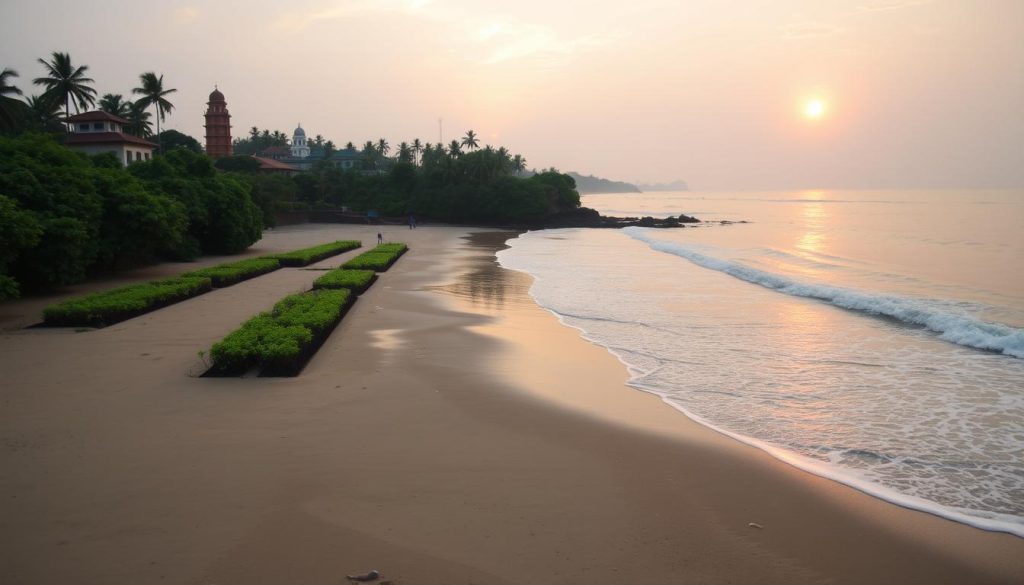
Keeping Varkala’s history alive is good for visitors. It also makes Varkala known for protecting Indian culture. By saving its historical sites, Varkala protects its past and future. This could inspire others in India to save their heritage too.
Cultural Syncretism: Varkala’s Rich Tapestry
Varkala is a bright example of Varkala cultural syncretism. Different cultural and religious backgrounds mix smoothly here. This mix shows in the lifestyle of the locals, the town’s architecture, and its yearly events.
Religious Coexistence and Architectural Styles
Varkala architectural styles are easy to spot across the town. Buildings combine Dravidian designs with Portuguese and British influences, showing Varkala’s history. This mix enhances Varkala’s beauty and represents peaceful living among different cultures and religions. It is interesting for historians and architects.
Festivals Celebrating Varkala’s Diverse Heritage
Varkala’s festivals show its rich cultural mix. Events like the Papanasam Beach Festival and the Sree Janardhana Swamy Temple Festival celebrate different practices together. These festivals let both locals and visitors see Varkala’s cultural diversity.
In summary, Varkala’s architecture and festivals show its cultural mix. Every part of Varkala, from its buildings to festivals, tells a story of cultural blending. This story is both inspiring and informative, offering a deep insight into India’s diversity to its visitors.
Conclusion
Varkala’s history is like walking through a history book. The town tells a story of timeless beauty and culture. Its ancient charm comes from myths and natural wonders.
The red cliffs of Varkala are famous in Kerala’s history. Here, stories of ancient roots and invasions mix with a mystical appeal that still attracts visitors.
Varkala is also looking towards the future. Its festivals and myths show a dedication to keeping its heritage alive. It’s like the Pancha Rathas of Mahabalipuram, a symbol of ancient architecture that still stands.
Varkala is a living museum. It holds onto the past while welcoming the future.
Keeping history alive is key in Varkala. They work hard to protect the natural landscape. Even with money problems and government issues, they stay committed. Coorg and Jaipur offer different historical and cultural experiences too. Each place is unique, but they all share Varkala’s spirit. They honor the past and are ready for the future.
This makes them a special part of India’s tourism.
FAQ
What are some of the mysterious aspects of Varkala’s past?
Varkala’s past is full of mystery. This includes its unique cliffs and ancient myths. Many legends and untold stories from old times add to its mystique.
How did Varkala’s geological wonders form?
The famous Varkala Cliffs formed over millions of years. Nature’s forces made these sedimentary formations. They are major natural monuments with ancient importance.
What is the significance of mythology in Varkala’s history?
Mythology is very important in Varkala’s history. Sacred texts and legends show its spiritual side. Tales about Sage Narada and Sivagiri Mutt are part of this.
What archaeological findings have been discovered in Varkala?
Archaeologists found ancient burial sites and temple remains in Varkala. These findings tell us about past beliefs and religious practices of its people.
How did major empires influence Varkala’s history?
The Cheras and later European powers like the Portuguese affected Varkala a lot. They changed its culture, art, and even its social structure. This helped shape Varkala’s history.
Are there any unexplored historical sites in Varkala?
Yes, Varkala might have hidden historical sites not yet explored. Finding and studying them could teach us more about its rich past.
What impact did colonial powers have on Varkala?
The Portuguese, Dutch, and British changed Varkala in big ways. They influenced the local culture and changed its economy and buildings during their rule.
How are efforts in conservation affecting Varkala?
Efforts to save Varkala’s old sites and monuments are ongoing. This helps keep its heritage alive. It also boosts tourism and helps the local economy.
What is cultural syncretism, and how is it evident in Varkala?
Cultural syncretism is when different cultures mix together. In Varkala, it’s seen in the mix of beliefs, building styles, and festivals. This shows its cultural diversity.
What festivals are celebrated in Varkala, and what do they signify?
Varkala has many festivals, like temple events and annual celebrations. These festivals show Varkala’s rich culture and the unity of its people.
